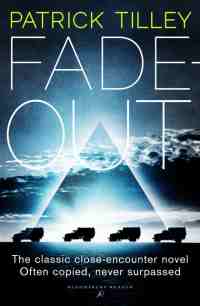Fade-Out by Patrick Tilley
 Friday, February 16, 2018 at 7:07AM
Friday, February 16, 2018 at 7:07AM 
First published in Great Britain in 1975; published by Bloomsbury Reader on December 14, 2017
Fade-Out was published in 1975, a simpler time when “the boys in the lab” solved the Earth’s problems while “the girls” were laying around getting “a nice suntan.” The novel has a dated feel that is enhanced by foreign policy debates about how the United States should handle the monolithic Soviet Union. The Berlin Wall came down only 14 years after Fade-Out was published. How quickly times change.
I’m not sure Fade-Out warrants Bloomsbury’s claim that it’s a “classic” that is “often copied by others.” In fact, the novel reprises First Contact themes have been an integral part of science fiction since at least the 1940s. At the same time, by the novel’s end, Fade-Out does have the feel of a classic, even if it’s a forgotten classic.
The book’s title refers to a “fade out” of radio wave reception that begins to afflict all parts of the Earth, albeit at different times. The boys in the lab figure out that something in orbit is causing the problem. They can’t see the thing, but they can detect it on radar. They are pretty sure it’s a ship and they surmise that the fade-out occurs when its propulsion system is activated. The boys in the White House reluctantly decide that the ship is of extraterrestrial origin, although they would prefer to blame the Russians.
The book’s initial chapters describe the political debate that surrounds the ET contact. Of course, the military wants to blow the ship out of the sky. More rational minds believe that starting an interstellar war would be unwise, but the conflict then revolves around the degree to which the United States should cooperate with Russia in addressing an alien presence. That debate intensifies when the fade-out continues after the ship buries itself in Montana.
Eventually we learn something about the ship (they name it Crusoe), and about the (apparently) big mechanical spider that exits from it (they name it Friday). Even the supposedly rational minds do precious little to communicate with the ET. They’re more intent on capturing Friday, or at least immobilizing it while they explore Crusoe. To that end, they do a number of things that would seriously piss off a human, apparently without considering that antagonizing an alien isn’t a smart approach to First Contact.
In any event, the humans who do manage to get inside Crusoe … well, I won’t give it away, but what they find isn’t what any of their team expected. Their close encounter of a very different kind sets the novel apart from others that have followed the same path.
The characters take occasional breaks to discuss philosophy (the nature and purpose of the universe, whether there’s an afterlife) and to debate scientific theories (the big bang versus the steady state theory, another aspect of the story that now feels dated). None of their musings add anything noteworthy to the story, except for the notion that lots of people don’t want to know the answers to the big questions, because the answers might unsettle their lives. One of the science-minded characters also accepts as fact some “scientific” theories about pyramids that have been debunked, and while that’s a small part of the story, it contributes to the novel’s dated feel.
I recommend the novel to fans of books (like The Martian) that feature scientists and engineers trying to puzzle out solutions to problems (like how to drop a bomb on a craft that disrupts electrical energy). Despite its dated feel, the story is reasonably convincing, and it ratchets up tension rather remarkably in the last 50 pages in a way that reminded me of the classic novel Fail-Safe. The ending is nicely ambiguous, which will bother readers who want everything spelled out for them. I was pleasantly surprised that the plot did not resolve in a more definitive way and that a couple of important loose ends were never explained. The rest of the book is good in sort of a predictable way, but to my mind the last chapter makes Fade-Out stand out. From the perspective of 2018, Fade-Out manages to be both dated and timeless.
RECOMMENDED
Reader Comments